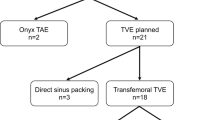Abstract
Introduction
The purpose of this study was to evaluate the utility of magnetic resonance digital subtraction angiography (MRDSA) in showing the presence or absence of retrograde venous drainage (RVD) in patients with intracranial dural arteriovenous fistula (DAVF) involving the transverse sigmoid sinus (TSS) after treatment.
Methods
Of 16 patients with DAVF involving the TSS, 13 underwent digital subtraction angiography (DSA) and MRDSA before and after treatment, and 3 underwent DSA before treatment and DSA and MRDSA after treatment. Five patients underwent these procedures twice after treatment. A total of 21 examinations after treatment were evaluated retrospectively. The presence or absence of DAVF and RVD was decided on the basis of the DSA findings. Two neuroradiologists reviewed the MRDSA findings concerning the presence or absence of DAVF and RVD.
Results
DSA showed residual DAVF in 9 and residual RVD in 5 of 21 examinations. MRDSA revealed residual DAVF in 8 of 21 examinations. MRDSA did not show residual DAVF in one examination because of a very small (low-flow) residual DAVF without RVD. MRDSA identified residual RVD in 5 of 21 examinations. MRDSA was completely consistent with DSA concerning the presence or absence of residual RVD.
Conclusion
MRDSA could evaluate the presence or absence of RVD in patients with DAVF involving TSS after treatment. MRDSA may give reliable information as to whether patients with DAVF involving the TSS should undergo additional DSA after treatment.


Similar content being viewed by others
References
Newton TH, Gronqvist S (1969) Involvement of dural arteries in intracranial arteriovenous malformations. Radiology 93:1071–1078
Awad I, Little J (1990) Dural arteriovenous malformations. In: Barrow D (ed) Intracranial vascular malformations. American Association of Neurological Surgeons, Park Ridge, IL, pp 219–226
Rodesch G, Lasjaunias P (1992) Physiopathology and semiology of dural arteriovenous shunts. Riv Neuroradiol 5:11–12
Willinsky RA, Taylor SM, TerBrugge K, Farb RI, Tomlinson G, Montanera W (2003) Neurologic complications of cerebral angiography: prospective analysis of 2,899 procedures and review of the literature. Radiology 227:522–528
Aoki S, Yoshikawa T, Hori M, Nambu A, Kumagai H, Nishiyama Y, Nukui H, Araki T (2000) MR digital subtraction angiography for the assessment of cranial arteriovenous malformations and fistulas. AJR Am J Roentgenol 175:451–453
Klisch J, Strecker R, Hennig J, Schumacher M (2000) Time-resolved projection MRA: clinical application in intracranial vascular malformations. Neuroradiology 42:104–107
Wetzel SG, Bilecen D, Lyrer P, Bongartz G, Seifritz E, Radue EW, Scheffler K (2000) Cerebral dural arteriovenous fistulas. AJR Am J Roentgenol 174:1293–1295
Coley SC, Romanowski CAJ, Hodgson TJ, Griffiths PD (2002) Dural arteriovenous fistulae: noninvasive diagnosis with dynamic MR digital subtraction angiography. AJNR Am J Neuroradiol 23:404–407
Noguchi K, Melhem ER, Kanazawa T, Kubo M, Kuwayama N, Seto H (2004) Intracranial dural arteriovenous fistulas: evaluation with combined 3D time-of-flight MR angiography and MR digital subtraction angiography. AJR Am J Roentgenol 182:183–190
Horie N, Morikawa M, Kitigawa N, Tsutsumi K, Kaminogo M, Nagata I (2006) 2D thick-section MR digital subtraction angiography for the assessment of dural arteriovenous fistulas. AJNR Am J Neuroradiol 27:264–269
Awad I, Little J, Akrawi W, Ahl J (1990) Intracranial dural arteriovenous malformations: factors predisposing to an aggressive neurological course. J Neurosurg 72:839–850
Malik GM, Pearce JE, Ausman JI, Mehta B (1984) Dural arteriovenous malformations and intracranial hemorrhage. Neurosurgery 15:332–339
Vinuela F, Fox AJ, Pelz DM, Drake CG (1986) Unusual clinical manifestations of dural arteriovenous malformations. J Neurosurg 64:554–558
Borden JA, Wu JK, Shucart WA (1995) A proposed classification for spinal and cranial dural arteriovenous fistulous malformations and implications for treatment. J Neurosurg 82:166–179
Cognard C, Gobin Y, Pierot L et al (1995) Cerebral dural arteriovenous fistulas: clinical and angiographic correlation with a revised classification of venous drainage. Radiology 194:671–680
van Dijk JM, terBrugge KG, Willinsky RA, Wallace MC (2002) Clinical course of cranial dural arteriovenous fistulas with long-term persistent cortical venous reflux. Stroke 33:1233–1236
Cognard C, Houdart E, Casasco A, Gabrillargues J, Chiras J, Merland JJ (1997) Long-term changes in intracranial dural arteriovenous fistulae leading to worsening in the type of venous drainage. Neuroradiology 39:59–66
Willinsky R, terBrugge K, Montanera W, Mikulis D, Wallace C (1994) Venous congestion: an MR finding in dural arteriovenous malformations with cortical venous drainage. AJNR Am J Neuroradiol 15:1501–1507
DeMarco K, Dillon WP, Halbach VV, Tsuruda JS (1990) Dural arteriovenous fistula: evaluation with MR imaging. Radiology 175:193–199
Satomi J, van Dijk JM, Terbrugge KG, Willinsky RA, Wallace MC (2002) Benign cranial dural arteriovenous fistulas: outcome of conservative management based on the natural history of the lesion. J Neurosurg 97:767–770
Golay X, Brown SJ, Itoh R, Melhem ER (2001) Time-resolved contrast-enhanced carotid MR angiography using sensitivity encoding (SENSE). AJNR Am J Neuroradiol 22:1615–1619
Gauvrit JY, Leclerc X, Oppenheim C et al (2005) Three-dimensional dynamic MR digital subtraction angiography using sensitivity encoding for the evaluation of intracranial arteriovenous malformations: a preliminary study. AJNR Am J Neuroradiol 26:1525–1531
Cashen TA, Carr JC, Shin W et al (2006) Intracranial time-resolved contrast-enhanced MR angiography at 3T. AJNR Am J Neuroradiol 27:822–829
Conflict of interest statement
We declare that we have no conflict of interest.
Author information
Authors and Affiliations
Corresponding author
Rights and permissions
About this article
Cite this article
Noguchi, K., Kuwayama, N., Kubo, M. et al. Dural arteriovenous fistula involving the transverse sigmoid sinus after treatment: assessment with magnetic resonance digital subtraction angiography. Neuroradiology 49, 639–643 (2007). https://doi.org/10.1007/s00234-007-0230-4
Received:
Accepted:
Published:
Issue Date:
DOI: https://doi.org/10.1007/s00234-007-0230-4



